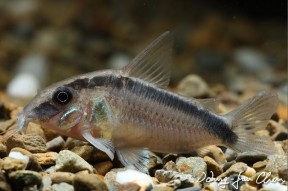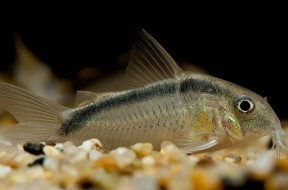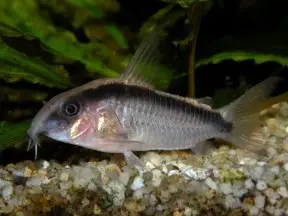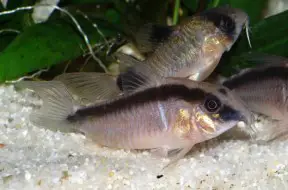Corydoras arcuatus
Skunk Cory; C020
Etymology
Corydoras: from the Ancient Greek κόρυς (korus), meaning ‘helmet’, and δορά (dora), meaning ‘skin, hide of an animal’, in allusion to the rows of bony plates on the flanks of genus members.
arcuatus: from the Latin arcuatus, meaning ‘curved’, in allusion to the shape of the dark stripe in the upper part of the body.
Classification
Order: Siluriformes Family: Callichthyidae
Distribution
This species was described from an aquarium specimen so its type locality is unknown although the holotype is said to be from ‘? Teffe, Amazon’ which would appear to correspond to the city of Tefé in Amazonas state, Brazil, some 500 km west of Manaus on the rio Solimões.
It’s generally considered to occur throughout the upper Amazon region in Brazil, Peru, Ecuador, and Colombia, upriver of the confluence between the Río Negro and Amazon main channel.
In the Negro it’s known to range upstream as far as São Gabriel da Cachoeira.
Records thus exist from the Solimões, Purus, Japurá, Caquetá, Yavarí, Tefé, Napo and Ucayali drainage basins although it’s worth noting that a number of similar-looking fishes also exist in the region, and only some of them are described to science (see ‘Notes’).
Maximum Standard Length
50 – 55 mm.
Maintenance
Ideally use a substrate of fine sand, although rounded gravel is an acceptable alternative provided it’s kept scrupulously clean.
Other décor is largely down to personal choice, but some cover should be provided to give the fish security.
Water Conditions
Temperature: 20 – 28 °C
pH: 5.0 – 7.5
Hardness: 36 – 215 ppm
Diet
Corydoras spp. are foraging omnivores and will accept most sinking dried foods, as well as small live and frozen varieties such as bloodworm, Tubifex, etc.
Feeding a varied diet will ensure the fish are in optimum condition.
Under no circumstances should they be expected to survive on ‘left-overs’ from other inhabitants of the aquarium or relied on to ‘clean’ the aquarium.
Behaviour and CompatibilityTop ↑
Peaceful and gregarious. Should be maintained in a group of at least 4-6 individuals.
Sexual Dimorphism
Females tend to grow larger, and sexually mature individuals are noticeably rounder and broader-bodied than males, especially when gravid.
NotesTop ↑
This species is among the more popular Corydoras in the aquarium hobby and is widely available. It may also be referred to as ‘arched cory’ and has been assigned the C number C020.
There exist a number of similar-looking congeners, particularly C. urucu (Britto et al., 2009), described from the rio Urucu in Coari municipality, Amazonas state, Brazil, and C. narcissus Nijssen & Isbrücker, 1980 from the rio Purus.
The latter appears to have also been traded as C. sp. ‘super arcuatus longnose’ while a large-growing, short-snouted form from the Purus has been assigned the code CW036 and is known as C. sp. ‘super arcuatus’.
While the latter pair can be told apart from C. arcuatus by their much larger adult size and in the case of C. narcissus the extended snout, C. urucu differs in having a more rounded snout plus the black body stripe does not pass through the eye, rather terminating behind it.
The genus Corydoras is among the largest catfish groups and currently contains over 150 valid species.
It’s included in the family Callichthyidae, of which members are often collectively referred to as ‘armoured’ or ‘mailed’ catfishes group due to the presence of bony plates in place of scales on the body.
Their taxonomy can be confusing, and numerous undescribed species are also thought to exist.
Fish of unconfirmed identification entering the aquarium hobby are therefore typically assigned a ‘C‘ or ‘CW‘ number for purposes of reference and organisation.
They are facultative air breathers and possess a modified, highly vascularised intestine which has evolved to facilitate uptake of atmospheric oxygen and aid survival in oxygen-deprived environments. In the aquarium you’ll occasionally see them rising to the surface to take in gulps of air.
The stiffened pectoral-fin spines are capable of piercing human skin and a ‘sting’ can be very painful indeed, so care should be exercised when handling them.
It’s thought that secretions from the axillary glands at the base of each spine may even be mildly toxic or venomous.
References
- Elwin, M. G., 1938 - Annals and Magazine of Natural History (Series 11) v. 3 (no. 13): 126-128
Corydoras arcuatus sp. n., an Amazonian catfish. - Britto, M. R., W. B. Wosiacki, and L. F. A. Montag, 2009 - Copeia 2009(4): 684-689
A new species of Corydoradinae catfish (Ostariophysi: Siluriformes: Callichthyidae) from Rio Solimões Basin, Brazil. - Ferraris, C. J., Jr., 2007 - Zootaxa 1418: 1-628
Checklist of catfishes, recent and fossil (Osteichthyes: Siluriformes), and catalogue of siluriform primary types. - Fuller, I. A. M., and H-G. Evers, 2005 - Verlag A.C.S. GmbH: 1-384
Identifying Corydoradinae Catfish. - Nijssen, H. and I. J. H. Isbrücker, 1980 - Bijdragen tot de Dierkunde 50(1): 190-220
A review of the genus Corydoras Lacépède, 1803 (Pisces, Siluriformes, Callichthyidae). - Reis, R. E., S. O. Kullander, and C. J. Ferraris, Jr. (eds) , 2003 - EDIPUCRS, Porto Alegre: i-xi + 1-729
Check list of the freshwater fishes of South and Central America. CLOFFSCA.








June 25th, 2016 at 4:32 pm
It’s my view that CW036 is the true arcuatus and C020 undescribed. See my article in CSG journal 2015